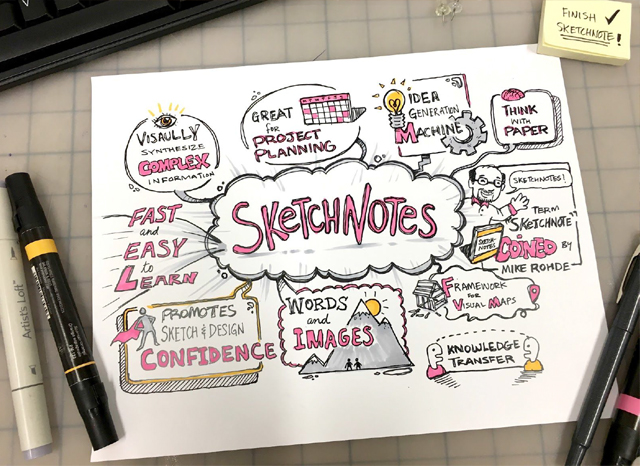Have you heard of ‘Sketchnoting,’ ‘Visual Note-taking’ or ‘Graphic Recording’? You may or may not have, either way in this article we will discuss how we use it and how we framed a workshop around it at the IDC 2018 (International Design Conference 2018) in New Orleans. We (Teddy Lu, IDSA, and Verena Paepcke-Hjeltness, IDSA) are educators who are using sketchnoting in the classroom, which we discussed in a paper called Design for Visual Empowerment.
This paper led Raja Schaar, IDSA, to invite us to conduct a workshop based on our sketchnoting experiences. Which we were super excited to do!
Below is a brief visual summary of how we define sketchnoting, how sketchnoting is making a difference in our work and a description of how we conducted the workshop. Let’s get started!
What are Sketchnotes?
In a nutshell, sketchnotes are visual maps of what we hear, see, and think using words and images (from Mike Rohde). Check out this sketchnote on sketchnoting!

Sketchnoting is Making a Difference
Teaching at two different universities, we have introduced sketchnoting over the years to many students, staff, and faculty.
Verena has taught sketchnoting on a regular basis over three years across campus at Iowa State University. Through workshops and courses, she reached approximately 1,000 people of varying backgrounds and disciplines ranging from faculty, staff, to students.
Teddy introduced sketchnoting to a sophomore design sketching class after realizing how it proved to be a powerful visual communication tool while working at a design consultancy. As a result, the student team Sketch Squad was born, and they are visualizing events and conferences on and off campus (Instagram and Facebook).
Sketchnote Workshop at IDC (More Than Pen Meets Paper)
We were invited to share our sketchnoting experience with the rest of the design community at the IDSA International Design Conference held in New Orleans, Louisiana. Focusing on basic sketchnote principles (which can lead to thinking on paper, while fostering creativity and enhancing engagement), we introduced sketchnoting and discussed its connection to design thinking through the correlation between divergent and convergent thinking.

As a warm-up, we used simple drawing techniques and basic shapes (square, triangle, circle, line and dot) that easily transition into images by breaking down complexity.
Drawing people tends to be more difficult than drawing objects, so we introduced ‘template people’ streamlining the process. Starting with just the basic facial shape, eyes, and mouth, you have enough to transform the drawing into any person by just adding a few details.
A big part of sketchnoting is the combination of images with text, so sketching different text styles can create hierarchy on the page. To create organization ‘containers’ are used to assign visual meaning to the content.

Now that we had the pieces in place, it was time to put it all together! Worksheets were used to help build the sketchnoting experience step by step. The topic was “Getting ready for a trip” and participants were asked first to write the steps of how they got ready for travel. Writing down their process of how they packed, booked their flights, arranged for hotels.
To keep the ideas fresh and create more conversations, the worksheet was passed to the neighboring person to sketch out what was written by the previous person. After sketching, the page was again passed onto another person for the final sketchnote. The last phase is about combining the writing with the images to create a sketchnote page that reflects the original
travel preparation journey.
The overall experience gave people the opportunity to explore the power of simple drawings. For the ones who were not comfortable sketching, it allowed an entry point to put pen on paper and to communicate visually. For the ones well versed in sketching, it provided a framework to reduce complexity and focus on the basics. One participant said, “I think this is a great way to approach user journey maps and explore the various ways to communicate an experience.”

Call To Action
We had a great time exposing the value of sketchnoting and will continue our journey towards spreading the idea of writing and drawing. It’s time to break the “rules” of traditional note-taking methods, and use sketchnotes to elevating design thinking and education in general. By spearheading sketchnotes as a skill to create sketch and creative confidence, we hope to inspire a new process for professionals, educators, and students and change the way we engage with information. So the next time you are faced with pen meets paper, we hope you don’t just take regular notes, try sketchnotes!
